Intel Atlas Canyon (NUC11ATKPE) and GEEKOM MiniAir 11 UCFF PCs Review: Desktop Jasper Lake Impresses
by Ganesh T S on July 14, 2022 8:00 AM ESTHTPC Credentials
The HTPC-related sections in previous SFF PC reviews covered a range of aspects. Display refresh rate stability (particularly, the ability to drive 23.976 Hz for stutter-free playback of cinema content), OTT streaming efficiency (YouTube and Netflix), and local media playback performance and efficiency evaluation were some of them. While such a detailed study may still make sense for dedicated HTPC reviews, we have decided to pare down the evaluated aspects for system reviews. Workloads were processed on the Intel NUC11ATKPE and the GEEKOM MiniAir 11 for the results in this section.
YouTube Streaming Efficiency
4K video streaming has become ubiquitous enough for its support to be a necessity even for secondary HTPCs. HDR has also become affordable - in fact, one of the key changes for HTPCs in Jasper Lake is the enabling of HDR over HDMI, a feature not available in Gemini Lake-based systems. Keeping these aspects in mind, we have chosen Mystery Box's Peru 8K HDR 60FPS video as our test sample moving forward. On PCs running Windows, it is recommended that HDR streaming videos be viewed using the Microsoft Edge browser after putting the desktop in HDR mode.
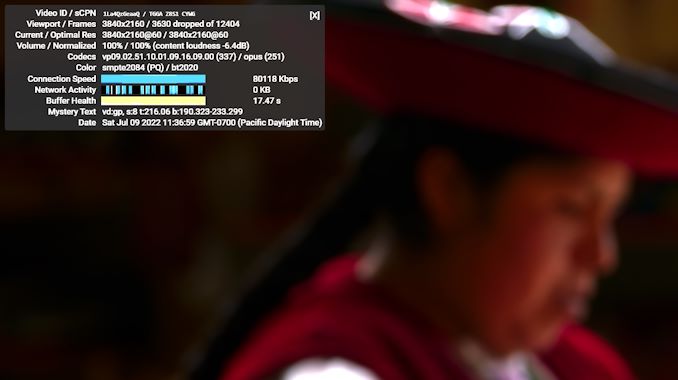
YouTube Streaming - Intel NUC11ATKPE (Atlas Canyon)
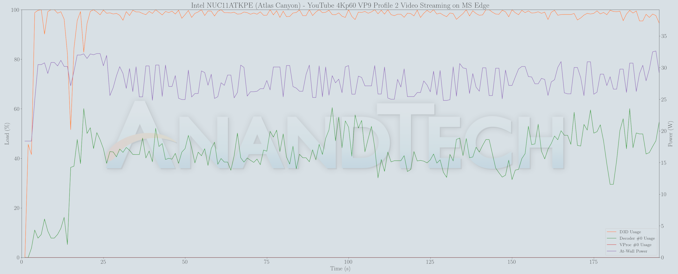
Intel's UHD Graphics for Gen 11 supports hardware decoding for VP9 Profile 2. Taking advantage of this feature, MS Edge automatically fetches the 4Kp60 VP9 Profile 2 encode from the YouTube servers. However, the playback was punctuated by frequent dropped frames on both systems as shown in the statistics segment of the screenshots in this subsection - similar to the behavior observed in the passively-cooled Jasper Lake units.

YouTube Streaming - GEEKOM MiniAir 11
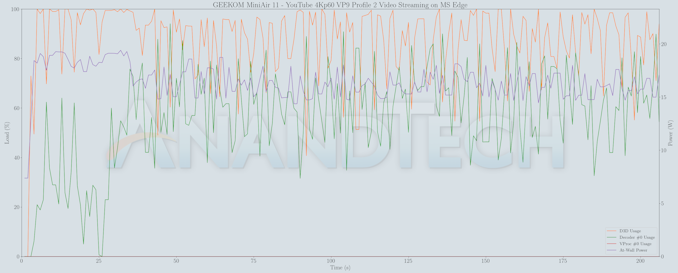
The reason for the dropped frames seems to be excessive D3D usage, which is not observed when playing back similarly encoded media in programs like Kodi or VLC. The fault here lies with MS Edge, but it is not clear how this can be fixed.
The reason for the dropped frames is evident by the spikes in D3D Usage. However, as we shall see further down in this section, this problem doesn't manifest itself in local playback. The culprit here seems to be the MS Edge browser itself, rather than the hardware platform.
Hardware-Accelerated Encoding and Decoding
The transcoding benchmarks in the systems performance section presented results from evaluating the QuickSync encoder within Handbrake's framework. The iGPU in the systems support hardware encode for AVC, JPEG, HEVC (8b and 10b, 4:2:0 and 4:4:4), and VP9 (8b and 10b, 4:2:0 and 4:4:4). The capabilities of the decoder engine are brought out by DXVAChecker. They were the same for both the Intel NUC11ATKPE (Atlas Canyon) and the GEEKOM MiniAir 11.
The decoder engine in Jasper Lake is not the latest and greatest that Intel has to offer. For example, HEVC and VP9 12b support, as well as AV1 support are absent. AV1 is quite new, and the others are required only for professional applications - market segments that are not targeted by Jasper Lake systems.
Local Media Playback
Evaluation of local media playback and video processing is done by playing back files encompassing a range of relevant codecs, containers, resolutions, and frame rates. A note of the efficiency is also made by tracking GPU usage and power consumption of the system at the wall. Users have their own preference for the playback software / decoder / renderer, and our aim is to have numbers representative of commonly encountered scenarios. Considering the target market for Jasper Lake systems, we played back the test streams using the following install-and-forget combinations:
- VLC 3.17.4
- Kodi 19.4
The fourteen test streams (each of 90s duration) were played back from the local disk with an interval of 30 seconds in-between. Various metrics including GPU usage and at-wall power consumption were recorded during the course of this playback. Based on the DXVAChecker report presented previously, the GPU should be able to play back all codecs with hardware acceleration (except for AV1).
All our playback tests were done with the desktop HDR setting turned on. It is possible for certain system configurations to automatically turn on/off the HDR capabilities prior to the playback of a HDR video, but, we didn't take advantage of that in our testing.
VLC and Kodi
VLC is the playback software of choice for the average PC user who doesn't need a ten-foot UI. Its install-and-play simplicity has made it extremely popular. Over the years, the software has gained the ability to take advantage of various hardware acceleration options. Kodi, on the other hand, has a ten-foot UI making it the perfect open-source software for dedicated HTPCs. Support for add-ons make it very extensible and capable of customization. We played back our test files using the default VLC and Kodi configurations, and recorded the following metrics.
| Intel NUC11ATKPE (Atlas Canyon) Video Playback Efficiency - VLC and Kodi | |||
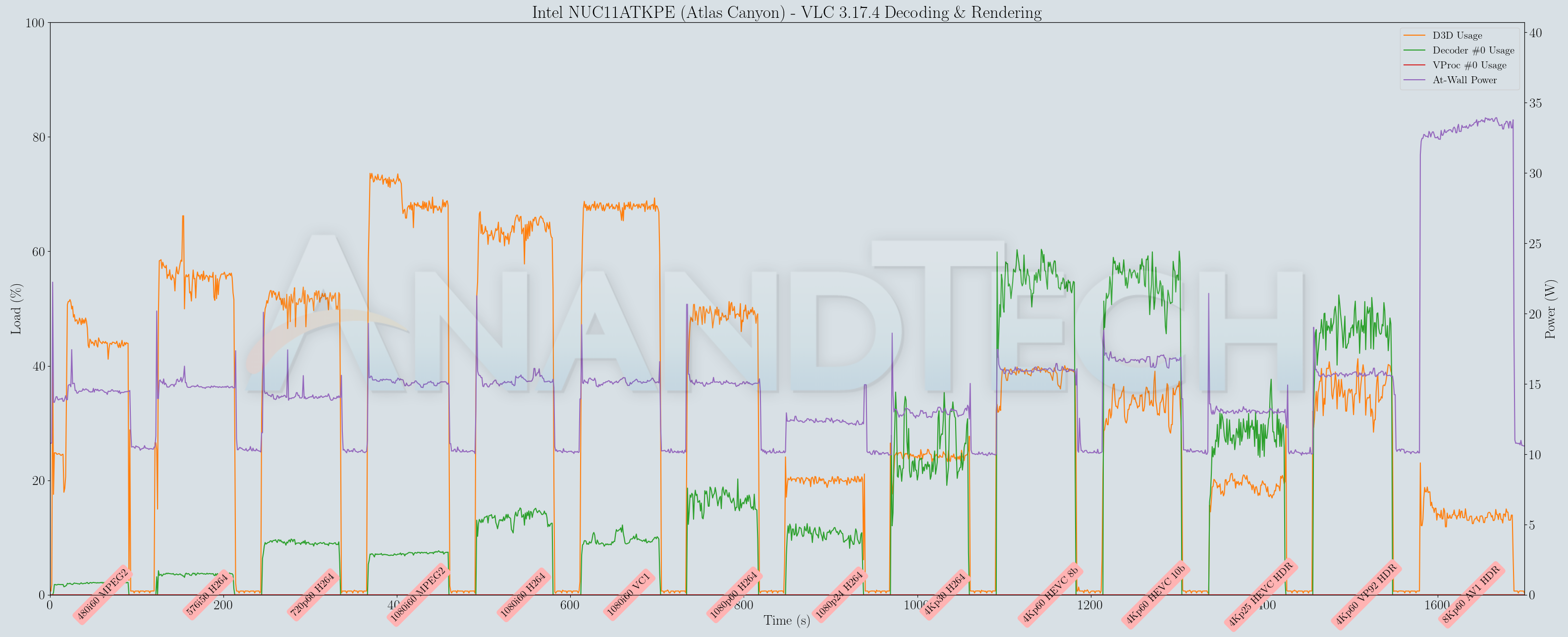
| GEEKOM MiniAir 11 Video Playback Efficiency - VLC and Kodi | |||
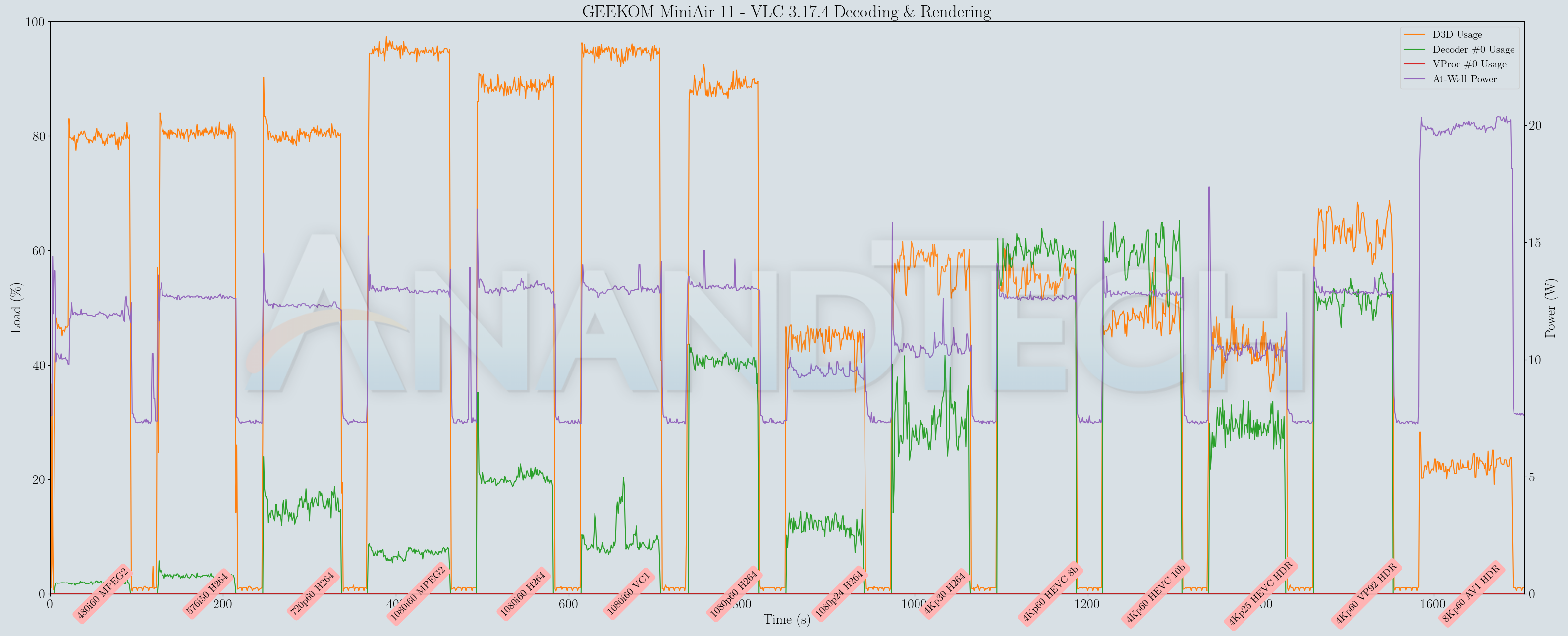
Both players in both systems had great trouble handling the 8Kp60 AV1 clip, due to the absence of hardware acceleration. In addition to consuming lots of power, the playback was just a sequence of frames updated every few seconds. Other than that, all other codecs played without missing a frame, with hardware acceleration activated for low-power playback.
Overall, both systems can be recommended for media playback from the local disk or over the local network. Using web browsers is a hit or miss depending on the codec, resolution, and browser. The presence of hardware acceleration also ensures that the systems are very power-efficient while handling playback workloads.


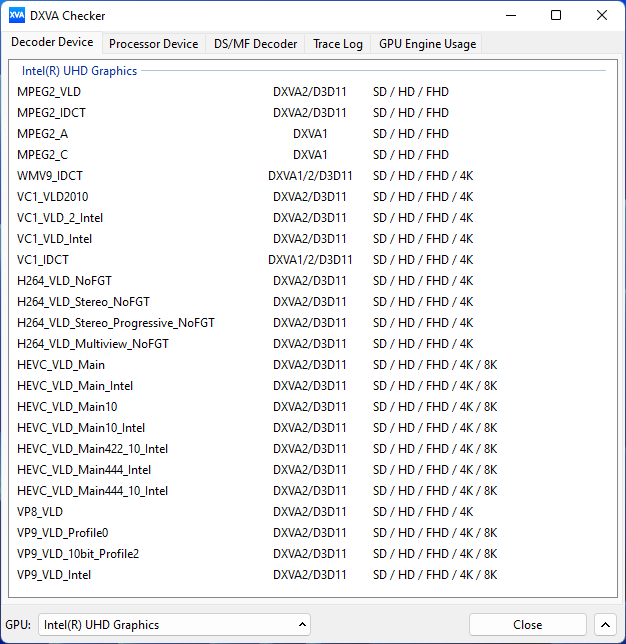








21 Comments
View All Comments
JWade - Thursday, July 14, 2022 - link
comparing the two, how would they be if they had equal amounts of ram?dmill - Friday, July 15, 2022 - link
Can you also do an in depth review of the new HP 11 Windows tablet. Compared to the Surface Go3 and link the benchmarks from these NUCs and something like the Asus Vivobook 13 Slate so we can see how the thermals compare please. I want to get the HP, but I'm afraid HP may has castrated the performance.mode_13h - Friday, July 15, 2022 - link
Thanks for your ongoing coverage of machines built around Intel's efficiency-oriented CPUs.I appreciate the inclusion of Cinebench, compression, & other benchmarks, but what I'd really like to see are SPEC2017 numbers. Especially for the NUC, where I think they would tell us how these CPUs compare with many others you've covered.
DigitalFreak - Saturday, July 16, 2022 - link
Intel doesn't even use their own NICs. How sad.mode_13h - Sunday, July 17, 2022 - link
That's weird. Could it be related to fab capacity?t.s - Monday, July 18, 2022 - link
Nope. They usually differentiate their product. Below i3, you get realtek NIC. i3 and higher, you get intel NIC. below i3, you'll miss something like avx2 or others feature. i5 and higher, business use, you get vPro. And so on and on..George2022 - Sunday, July 17, 2022 - link
The progress over previous offerings in this class is obvious. Also visible is the lag due to the output delay. I hope Intel catches up next year with a significantly better product equipped with DDR5 RAM, and most modern external interfaces and inner technologies.mode_13h - Sunday, July 17, 2022 - link
I doubt they'll use DDR5, at this level. It's not really necessary and still commands a price premium that doesn't make a lot of sense for such a budget platform. Maybe its best selling point for systems at this price tier would be the performance improvement on single-DIMM configurations.Bruzzone - Sunday, July 17, 2022 - link
Panther Lake Tiger NUC 11 was a failure and barely produced beyond sample volume. Tremont Jasper Lake was introduced in February 2021 but did not ship till April and the J desktop version was not shipped at all until Atlas Canyon NUC that is a full 15 months after mobile N offerings became available. This week in the WW channel N mobile devices represent approximately the same volume in the channel as Alder i3 which is only 2.5% of AL for the week running 1.98% of full run volume to date. To date jasper Lake N mobile sales have been flat and only Celeron N4500 cleared down 43% in the last 11 weeks which is some sort of flushing because otherwise N sales are basically flat since launch. Speaks of Atlas Canyon? mb